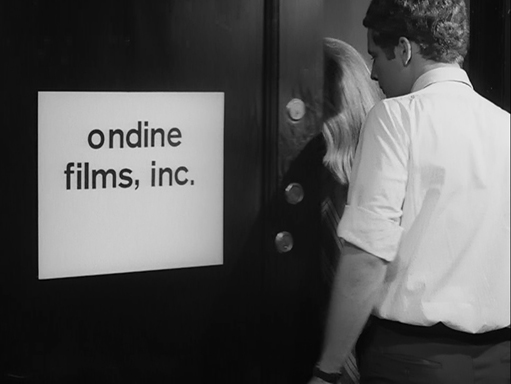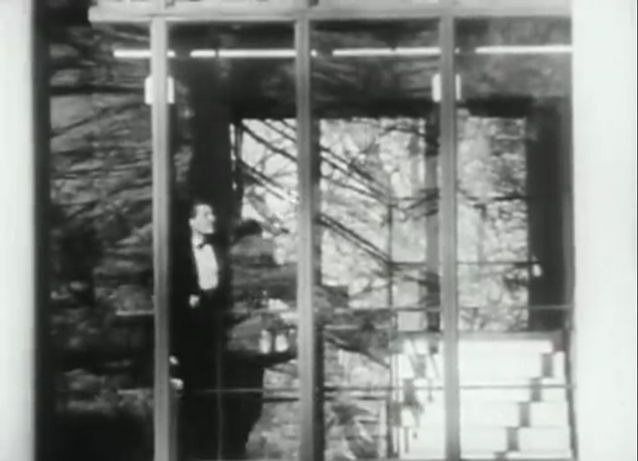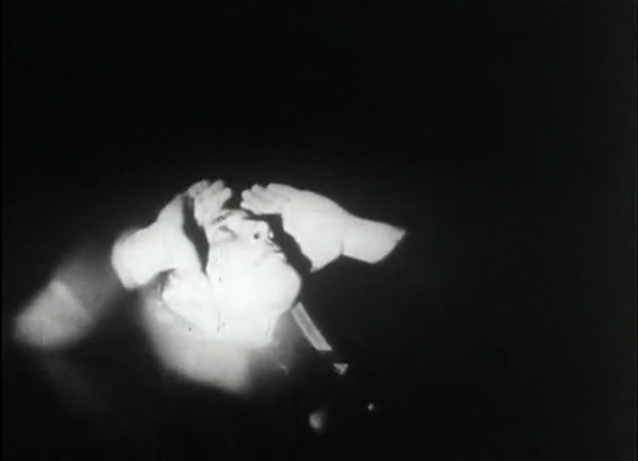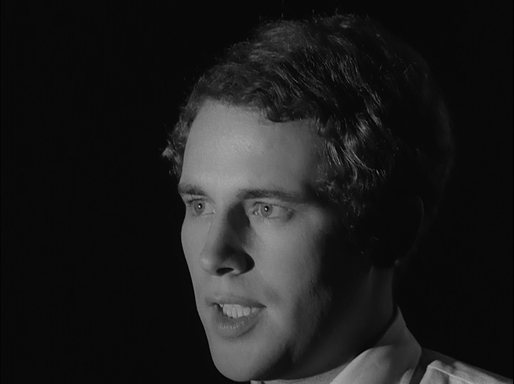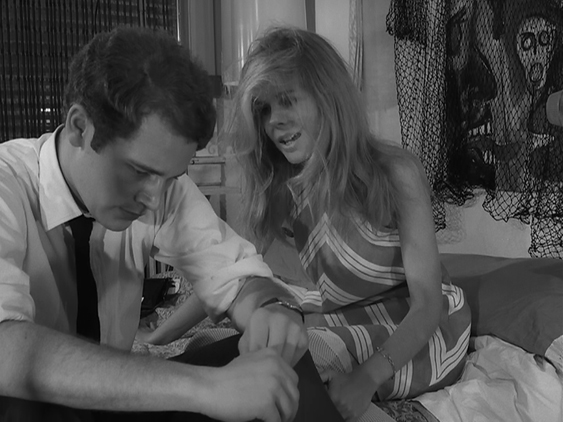OZON CITES DE PALMA, HITCH, CRONENBERG
AS STYLE-GUIDES FOR HIS NEW THRILLER 'L'AMANT DOUBLE' AT CANNES
The world premiere of
François Ozon's new thriller,
L'Amant Double, caused a stir at the Cannes Film Festival the other day.
Reuters' Robin Pomeroy (courtesy the New York Daily News) reported, "The story of a young woman who has an affair with her psychiatrist and then his twin brother delivers lots of sex and even more Freudian symbolism in a film that Ozon said borrowed some of the styles of
Alfred Hitchcock, Brian De Palma and
David Cronenberg." According to Pomeroy, Ozon "said he had fun pushing the boundaries of the erotic thriller genre that he has visited before in films such as the 2003 movie
Swimming Pool that also competed at Cannes."
Pomeroy then quotes Ozon: "I love the way De Palma deconstructs the thriller and how he has fun playing with the codes of the genre."Here are links and excerpts from some of the reviews:
Renan Cros at Cinema Teaser
Over-symbolic, the film descends into a completely sterile sexy-chic bad trip that is dreadfully threadbare. A haphazard amalgamation of Polanski’s neurotic cinema, De Palma’s twisted voyeurism and Cronenberg’s freak shows, L’Amant Double is an ersatz 80's movie corseted by the auteur of the 2000s. That is to say, in fact, a crazy film that looks at itself, always more theoretical than dynamic and embodied. Thus, Ozon unfolds his little supposedly perverse and eloquent program without ever succeeding in getting his salutary ideas and bad taste off the ground to anything other than an intellectual device. The intra-vaginal plane that opens the film is surprising. One smiles, one settles for the roller-coaster. But in the second, Ozon is mired in a worn-out metaphor, a nerdy symbolism that sees the vagina turn into an eye of the heroine - a heavy nod to the Story of the Eye of George Bataille, an essential work on eroticism. And the whole film works thus, in a painful back and forth between a falsely provocative (but rather funny) first degree and an over-intellectualization that ruins all pleasure. A hysterical film, L’Amant Double then becomes a frigid film that never succeeds in enjoying and making its audience enjoy its supposed excess. In vain multiply the effects and push the taboo, we remain impassive in front of a film devoid of intensity that looks more like Fifty Shades Of Grey than Body Double. Where De Palma embraces bad taste, nourishes him with his obsessions and his romanticism, Ozon makes a film brain where excess is only a clinical sign, a metaphor to decode. Disembodied, the film painstakingly follows its specifications, accumulates the clichés on the fantasy representation of female sexuality and sloughs in a climax that falls flat. Above all, and perhaps the most unpleasant, the film does not go anywhere, merely packing his little mystery in a long awaited resolution that finally extinguishes the fire that could have gushed out. Too bad, because the nagging disorder at the heart of this dual story, combined with the rather amusing performance of Jérémie Rénier, could have given, with a little more letting go and inventions, a thriller more shaking and endearing than this pale copy of a pupil too wise.
Robbie Collin at The TelegraphThe films of François Ozon operate on a heightened plane that should really be called the Ozon Layer – a realm of thin air, light heads and giddy views where the French provocateur has carved his niche. His latest, which drew screeches of delight from critics at the Cannes Film Festival last night, is an erotic thriller based on the Joyce Carol Oates novel Lives of the Twins, in which an initially sexually inhibited psychiatric patient (Marine Vacth) embarks on simultaneous affairs with her therapist (Jérémie Renier) and his twin brother (Jérémie Renier again, with his hair combed differently), who is also a therapist. Shiveringly sexy and slippery as satin, with its tongue stuck everywhere including its cheek, it’s like the wildest Frasier episode they never made, and hits all the parts – sometimes literally – the Fifty Shades of Grey films couldn’t hope to reach. Before going further, it’s worth a cautionary word about what can only be described (even though it follows a brief prologue) as the film’s opening shot, which involves a certain female body part, an engaged speculum, and one of the most jaw-dropping camera pull-back-and-reveals in cinema history. The pale pink part in question belongs to Chloe (Vacth), an ex-model whose persistent stomach pains since puberty have baffled medics, so she enlists a therapist called Paul (Renier) to get to their possibly psychological root.
In their first session he’s clearly smitten within minutes of her breathy monologuing – as, in all likelihood, will be half the audience. Like her schoolgirl nymphet in Ozon’s 2013 film Jeune et Jolie, Vacth’s role here is a stock male fantasy character – the beautiful but frigid woman who just needs a good you-know-what – which she and the director go on to teasingly turn on its head. Wearing androgynous jumpers and sharp trouser suits and with her hair in a boyish crop, Chloe by no means conforms to the sugar, spice and all things nice template, and her sex scenes have an androgynous quality which the script goes on to push to ever-kinkier heights.
It begins with Chloe’s discovery of Paul’s estranged twin brother Louis, who runs a rival psychiatric practice across town – and who carries out his “applied techniques” on a fur-covered bed in his clinic, for €150 a session (she pays him). Unorthodox they may be, but they’re also undeniably effective: poor old Paul, who’s long since transitioned from medical caregiver to live-in boyfriend, can hardly compete. During one orgasmic gasp, Ozon’s camera slips between Chloe’s parted lips like an endoscope, before rushing through her insides to reveal various membranes appreciatively fluttering.
This arrangement isn’t exactly viable in the long term, but Paul and Louis are both harbouring secrets that make it extra shaky – and as Chloe pries into their pasts, she senses her own life may be at risk. (The film’s French title, L’Amant Double, The Double Lover, is a pun on L’Agent Double, The Double Agent.) Mirror images are everywhere: there’s barely a room in the film without a reflective surface somewhere, and Ozon stages his scenes so that characters seem to fracture into multiple versions of themselves before coalescing with a turn of the camera. During the therapy sequences, mirrors and split screens are deployed to make consultations look whisperingly intimate, shortening the space between his characters until they’re close enough to kiss – while a scene on a spiral staircase looks like a Saul Bass hallucination in architectural form.
Ozon’s Alfred Hitchcock influences have never been hard to spot. His previous film, Frantz, was an elegant rethinking of Vertigo in postwar Europe. But here he tears his shirt off and goes full Brian De Palma, with sinuous tracking shots, shattering glass and mad narrative gambits in which the lines between reality and illusion are deviously blurred, and certain objects are piled up with absurd degrees of metaphorical significance: just wait for the stuff with the cats. During one showpiece sex scene involving multiple partners, Chloe unfolds down the middle like a Rorschach print, all the better to simultaneously satisfy all participants. It’s a fantasy not of sexual satisfaction but sexual accomplishment, and perhaps no director other than Ozon would have the imagination and panache to carry it off.
Stephanie Zacharek at TIMEBut if many of the movies at this year’s Cannes struck a somber or thoughtful chord, there was joy to be found too. In Francois Ozon’s rapturously twisted, Brian De Palma-style thriller Amant Double, a young woman suffering from possibly psychosomatic stomach pains (Marie Vacth) falls in love with her therapist (Jeremie Renier), whose secret life draws her into a web of deceit and kinky sex. Yet more proof, should you need it, that the French really know how to live.
Kyle Buchanan at VultureYou would think, then, that there would be few taboos left to shock a Cannes audience, but at tonight’s screening of the new film from French director Francois Ozon, L’Amant Double, there was one nude moment so audacious that the press gasped, laughed, and ultimately applauded. The entirety of L’Amant Double is pretty sex-soaked — Ozon basically channels Brian De Palma as he tracks troubled Chloe (Marine Vacth), who’s carrying on some awfully explicit affairs with twin psychiatrists (both of whom are played by Jérémie Renier, who’s game to make out with himself and get pegged) — and Ozon signals his gleeful intent with the very first shot after the opening credits. That shot, dear reader, is a close-up of Chloe’s vagina spread open by a speculum.
Now, it’s always a little startling when you’re greeted with surprise vagina so early into a movie, and if you’re used to comparatively tame American films, it’s certainly novel to see that female orifice projected onto an IMAX-size screen as the whole audience gasps and titters. Still, even though I’m a gay man, I’d like to think I’m a veteran of surprise vagina at Cannes: Just last year at the festival, a tender lovemaking sequence in Staying Vertical suddenly smash cut to a baby’s head messily protruding from a woman in labor. (And that, kids, is how I met your mother.)
What I’m saying is, while L’Amant Double’s lovingly photographed close-up of a vagina certainly sent a jolt through the audience, it wasn’t just the vagina that made this moment an instant classic. It’s what Ozon did next that sealed the deal: The director match cut from one oval shape to another, dissolving from Chloe’s vagina to a shot of Chloe’s eye, the folds of skin around each matching up almost exactly. And then, just as the audience thought to themselves, He really did that, huh? Ozon took things one step further: A single fucking tear fell out of the eye.
It was so ridiculous, so earnest, and so beyond the beyond that the audience had to applaud. That is a serious chutzpah cut, to match a woman’s spread vagina with her crying eyeball, and I can’t imagine the level of commitment it requires to script such a thing, let alone to explain it to your actors, shoot it, and not laugh every single day in postproduction. I would say Ozon has some serious balls, but I’m not sure that’s the right anatomical metaphor to use when we’re discussing a scene with surprise vagina.
Fionnuala Halligan at Screen DailyYou’ve got to hand it to a film which takes a speculum-eye shot of a cervical examination as one of its opening images. Like Elle last year, and playing almost in the same timeslot, Francois Ozon’s Amant Double is gleefully flashy, trashy fun. Paying homage to Brian De Palma — and, indeed Elle’s director Paul Verhoeven - it was a big surprise from a director whose last film was the sober and mysterious black-and-white World War I drama Frantz. And it’s such good fun to see a Ozon, who also wrote, enjoying himself like this, even if the film verges towards the hilariously lurid with its stuffed cats and sidelong glances. (Jury president Pedro Almodovar might have glimpsed some of his own influence at play here, in particular Cannes competitors Broken Embraces or The Skin I Live In. All roads lead back to Hitchcock, of course). Body doubles, shattered glass and jagged mirrors are Ozon’s currency in this story of an emotionally unstable woman (Marine Vacth) who forms a relationship with her therapist (Jeremie Renier) and discovers he has a violent twin brother with whom she also becomes sexually entangled. It’s all rather salacious and determinedly frivolous, moving from cervix to strap-on in a most agile fashion. Renier is smooth in both parts, Vacth is riveting, if a little bug-eyed on occasion, Jacqueline Bisset lends gravitas.
Sam Gray at The Up ComingAt this point in the festival, when spirits are flagging and sleep is but a fond memory, a dose of unadulterated craziness is required to see critics through the final stretch. Step forward François Ozon. After a few attempts at mainstream success, he’s reverted to his craziest, most sexually charged instincts with L’Amant Double – which is basically Dead Ringers by way of Brian De Palma, with a dash of Rosemary’s Baby thrown in for good measure. Beginning with a match cut so outrageous it prompted a round of applause, Ozon settles into the story of Chloé (Marine Vacth), a woman who starts attending therapy in the hope of curing the pains in her stomach. Her therapist Paul (Jérémie Renier) is so handsome, though, that they soon end up violating the ethical code of conduct, in several different rooms and positions. Along with Chloé’s sassy cat, they move into an apartment together, and all is apparent bliss – until she begins to visit a different therapist, who looks an awful lot like her beau… He’s also played by Renier, and he’s revealed to be Paul’s twin brother. Representing two different sides of masculinity, Chloé obviously starts screwing them both, while trying to uncover the reason behind their animosity towards each other.
And that’s just the start of it. Overripe and ridiculous, L’Amant Double is so filled to the brim with pure cinematic imagery and knowing irony, with innuendo and gleeful violations of taste, that it’s hard to resist its barrage of hilarious filth. Cats, mirrors and foetuses are mixed into a heady brew of double-crossing and sex – so much sex, including a memorable sequence involving “pegging”. (If you don’t know it, look it up in private.)
De Palma’s name has been mentioned once, but it demands to be summoned several times over, so clear is this film’s purpose in pushing the boundaries of taste in the name of not-so-guilty entertainment. It’s nonsense, of course – while based on a short story by Joyce Carol Oates, Ozon has only a passing interest in the identity issues of twins, instead devoting his time to titillating, shocking and amusing his audience. It might suffer outside the festival environment, but it’s almost certainly the most fun this critic’s had at Cannes so far.
Jon Frosch at The Hollywood Reporter"Loosely based" on the Joyce Carol Oates novel Lives of the Twins (written under the pseudonym Rosamond Smith), this gloriously trashy, shamelessly derivative mashup of David Cronenberg's Dead Ringers, Brian De Palma's Sisters and Roman Polanski's Rosemary's Baby should have no problem finding an audience in European and North American art houses. Its reception in France's psychoanalytic and psychiatric circles may be less assured; the film is like a feature-length PSA against Gallic shrinks. The story opens with Chloe (Marine Vacth of Ozon's Young & Beautiful), a quintessential Parisian beauty of 25, whom we see glowering into the camera as she gets her hair cut; the resulting pixie 'do recalls Mia Farrow's Rosemary, just the first in Ozon's giddy parade of cinephilic winks and nods. We then find Chloe in a gynecologist's examining room, where the doctor tells her that the abdominal pains she's been suffering from are surely anxiety- or depression-related. Chloe asks for a psych referral: "I think I'm ready," she says rather gravely.
Cue her first appointment with Dr. Paul Meyer (Dardenne brothers regular Jeremie Renier), a blond, boyishly handsome therapist whose sweater-and-spectacles look is as reassuring as his professional manner. Chloe immediately takes to their sessions, certain moments of which Ozon presents via split-screen placing the two characters in an intimate face-to-face formation. "When I see you, I feel like I exist," Chloe confides at one appointment, noting that her melancholy and ennui — as well as her stomach symptoms — have lifted.
Peter Debruge at VarietyWhile its grasp of human nature (especially that of the fairer sex) seems hopelessly dated, L’amant double nostalgically evokes such naïve psychological thrillers as Spellbound and Basic Instinct, suggesting some kind of mutant love child hatched between Alfred Hitchcock and Paul Verhoeven, though its fingerprints are undeniably Ozon’s. The director announces his outré intentions from the get-go, opening with the unfamiliar sight of a gynecological exam, an extreme closeup of which fills the screen: pink, moist, and distorted just enough that it takes a moment to register what we’re looking at. By match-cutting from this ultra-intimate POV to that of a blinking eye turned sideways, Ozon intends to shock — although Lars Von Trier got there first, in Nymphomaniac, a movie whose playful perversity may well have made this project possible.
This peekaboo moment belongs to a 25-year-old ex-model named Chloe, who complains of stomach aches (to extend the Nymophomiac connection, she’s played by Vacth, who looks like Stacy Martin, and sounds like Charlotte Gainsbourg). Her doctor advises that she see a shrink, and so the timid young lady finds herself in the office of Dr. Paul Meyer (Renier), a tweedy, somewhat conservative therapist who listens quietly while she seductively over-shares. Ozon has fun with these sessions, framing them via split-screens and other Brian De Palma-esque visual tricks that serve either to double the characters, or else to push them in closer to one another, till they appear as familiar as lovers.
David Ehrlich at IndieWire“What the hell am I looking at?” That’s the question most viewers will likely ask themselves during the opening moments of François Ozon’s (Swimming Pool) latest film. Following the opening credits sequence, in which a severe young woman’s face is revealed as her bangs are snipped away from over her face, Ozon cuts to an extreme close-up of something pink and fleshy and soft as gauze. Is it the soft tissue of a human brain? The camera begins to zoom out. The inside lining of an open mouth? The camera zooms out even further, until… the young woman’s clitoris comes into focus at the top of the frame, as do the gynecological devices that are prying her vagina open. It’s a hilariously explicit way of starting a movie, even before Ozon punctuates the moment with a match-cut to the girl’s eyeball, cementing the relationship between her sex and her psychology.
Welcome to L’amant Double (The Double Lover), a fitfully amusing erotic thriller in which nothing is what it seems, anything could happen, and everything is at least a little ridiculous. Much sillier than anything Ozon has made before — it unfolds like an overcorrection to the prolific French filmmaker’s staid and serious Frantz — but still lubricated with his usual psychosexual Euro-sleaze, this kinky story of jealousy and obsession feels like it’s been genetically engineered from the D.N.A. of Dead Ringers and Possession with a little bit of Brian De Palma thrown in for good measure. Or maybe it’s just the horniest movie that Alfred Hitchcock never made? Or maybe there’s simply no precedent to a Cannes Competition film in which someone yells “Just get your fetus out of here before I kill you!”
John Bleasdale at CinevueNothing here is supposed to be taken all that seriously and Ozon cheerfully piles on the weird: a quirky neighbour (Myriam Boyer) with a stuffed cat lurks next door and Jacqueline Bisset shows up though who she is will remain unclear until the end. Brian De Palma is an obvious influence and through him Alfred Hitchcock, though Ozon has credited a Joyce Carol Oates short story as his direct inspiration for L'Amant Double's story.
Tomris Laffly at Film Journal InternationalFrançois Ozon can always be trusted to shake things up a bit at a film festival. During last year’s Telluride, his gorgeous, black-and-white period melodrama Frantz became a sleeper, word-of-mouth hit among festival-goers. It’s hard to believe the same artist is behind L’Amant Double, which charged the audience with a jolt of energy on top of the festival’s final weekend after more than a week of mostly heavy and serious competition titles. A sexy, deliciously silly and twisty thriller that laughs in the face of commonplace reason and ecstatically dials up its weirdness at every plot turn, Ozon’s film was a welcome reminder of the possibilities of cinema and its ability to fiendishly pull the rug from under a viewer. Everyone in Cannes was mesmerized by the presence of Twin Peaks at the festival, but those who mostly prioritized the competition section titles got a generous taste of Lynch with toppings reminiscent of Hitchcock and De Palma in L’Amant Double.
Jordan Farley at Games RadarOpening with the most outlandish match cut of the festival – a gynaecological, frame-filling close up of a vagina that transitions into a weeping eye – François Ozon’s psychosexual thriller L’amant Double (The Double Lover) starts silly, and only gets more outrageous from there. Like De Palma directing Joe Eszterhas, it’s a film without a subtle bone in its immaculately sculpted body and, in its own self-consciously trashy way, is great fun.
A.A. Dowd at A.V. ClubL’Amant Double (Grade: B) is delirious premium trash, like Brian De Palma or Paul Verhoeven remaking Dead Ringers from the Geneviève Bujold character’s perspective. It’s ludicrous, sleazy, and silly—perhaps better suited to the beach down the street from the Palais, tucked within the pages of a paperback you purchased in the Nice airport, than in the theater itself. But Ozon stages it with a slumming Hitchcockian verve, and I confess that its pulp pleasures were just what the doctor ordered this late into the festival. The programmers knew what they were doing saving it for the homestretch.
Nikola Grozdanovic at The PlaylistLoading up Brian De Palma, David Cronenberg and Roman Polanski on three jukebox machines, and pressing play on all at the same time while running around the room with his pants down, Francois Ozon serves up L’Amant Double on a soiled platter. The provocative Frenchman is having a lot of fun with his new sexy thriller, and while you may hear some deriding it for its uncouth treatment of the central female character, or calling it sensationalist trash, you can still join Ozon’s party by putting your convictions and politics on the side and let the film surprise you with its eye-widening shocks and pitch-black humor. And besides, it is sensationalist trash and that’s OK. It doesn’t pretend to be anything other than a twisted riff on the age-old doubles motif (the French title literally translates to Double Lovers) and a lavish spectacle of style. Within the first few seconds, Ozon already divides half the audience. An opening (emphasis on opening) that signals the film’s shameless attitude towards sex introduces us to distraught and stressed out 25-year-old Chloe, played by Marine Vacth (who previously starred in Ozon’s Young and Beautiful). Her stomach pains are diagnosed as a psychological symptom and she gets referred to psychoanalyst Paul (Jeremie Renier) to find out what’s really going on. We learn about Chloe’s lonely life: she doesn’t have many friends, lives alone with her cat Milo (reprising his role from Elle, apparently), is an only child, doesn’t have contact with her parents, and only recently just got a job. This job of hers becomes an outlet for Ozon, cinematographer Manu Dacosse and set designer Sylvie Olive to give L’Amant Double a chillingly absurd look. She’s a part-time security guard at a post-modern museum of Lynchian proportions; disturbing images of organs and installations of twisted trees, among other oddities, abound in this otherwise synthetically-white space. As Paul says at one point: charming.
After a few sessions, which Ozon’s screenplay rushes through with a montage of quasi-split screens and perplexing angles, patient and therapist fall in love. “When you look at me like that,” she says, “I feel I exist.” The meshing of identity is, of course, the film’s central theme and Ozon frantically uses all sorts of techniques with image to present it visually and pump the film with extra pulp. They move in together in a new condo (on the 13th floor, naturally), Chloe meets her new nosy neighbor who’s her own breed of cat person, and then, one day, she sees Paul talking to a woman on the street. Paranoia sets in, the stomach pains return, and with Paul in full denial, she does some investigating. The man she saw is, in fact, Louis (also played by Renier), Paul’s mysterious alpha-twin who is also a psychoanalyst but a much more virile one.
That’s when L’Amant Double switches gears and goes to full-on berserker mode, so divulging anything else from the plot would be taking away half the fun. Not knowing what’s going to happen next is one of the film’s greatest advantages; Ozon creates wrought tension in the atmosphere as the unreliable and fragile Chloe seems to be reacting more than acting to situations. Spiraling down the rabbit hole, our Alice is seen through a cracked looking glass throughout most of the film. The mirror is the primary visual motif here, often magnifying and duplicating Chloe in a visual language that immediately recalls De Palma’s affinity for playing with reflection. Adding to the unhinged atmosphere is Vacth’s unrefined and seductive performance; she never seems calm and truly at peace, as if something from within is looking to rip out of her skin at any given moment. Philippe Rombi’s sinister score metamorphoses L’Amant Double into a horror film somewhere around the middle mark, once the danger gets closer to the front door, and our suspicions of Chloe’s depersonalized state continue to rise while the laughs continue to pile up.
Borrowing heavily from films like Sisters, Obsession, Rosemary’s Baby and Dead Ringers, Ozon’s film has the appropriately sleazy touch of camp and bat-shit wonky direction to become a cult twin-thriller. The cinematic trickery on display – lurid dissolves, off-kilter juxtapositions, and bizarre dance numbers bouncing around Chloe’s brittle mindscape – compensates for the skin-deep thematics, and keep the rhythm of the film popping. As the shocking twists and ludicrous scenarios escalate, the tale twists towards a satisfying conclusion, and the lascivious tone becomes more and more humorous as the film’s thrifty pace slinks along. Ozon even manages to accelerate the momentum of the film’s most powerful animal motif – cats are tied into the film’s fabric of sex, twins, voyeurism and horror in a surreal and fundamentally creative way.
Nicholas Bell at IoncinemaOzon’s twin leitmotif recalls the obsessive erotic thrillers of Brian De Palma, a garbled barrage of doppelganger red herrings which casts doubt on Chloe’s psychological state. The possibility we’re merely existing in the mire of her repressed sexual fantasies is always hovering on the periphery. But if De Palma comes to mind, so does a slew of other 70s era genre stalwarts, and Amant Double seems to have been influenced by the body horror of Cronenberg, most obviously Dead Ringers (1988) and The Brood (1979).
Alejandro G. Calvo and Eulàlia Iglesias at SensacineThe opening sequence of L'amant doublé, the return of François Ozon to the Cannes competition after presenting Young and Beautiful in 2013, is already a declaration of intentions: a close-up of a vaginal cytology that warns that this is going to be anything but an accommodating film. Almost as a tribute to the master Brian De Palma - both the early, Sisters (1973) and the late, Femme Fatale (2002) - the Ozon film delves into the high voltage psychological thriller, following the steps of a young woman (Marine Vacth, with a haircut reminiscent of Mia Farrow in Rosemary's Baby (1968)) caught between two men who are also twin brothers (and psychiatrists). With David Cronenberg's Dead Ringers (1988) as the most direct point of reference, Ozon has become a pirate, taking the dimensions of the girl's nightmare and his own discourse (recycled from many titles before) to a visceral level on the fragile and perfidious balance that exists between the strong brother and the weak brother in a pair of twins.
 Gazet Van Antwerpen's Jan Stassijns reported yesterday that Brian De Palma and his crew had landed in Antwerp for shooting on his new thriller, Domino. An announcement had been made by the Antwerp city government, according to a similar article by De Redactie's Joris Truyts, who added that De Palma will shoot scenes for the film within the cities along the Scheldt.
Gazet Van Antwerpen's Jan Stassijns reported yesterday that Brian De Palma and his crew had landed in Antwerp for shooting on his new thriller, Domino. An announcement had been made by the Antwerp city government, according to a similar article by De Redactie's Joris Truyts, who added that De Palma will shoot scenes for the film within the cities along the Scheldt.










